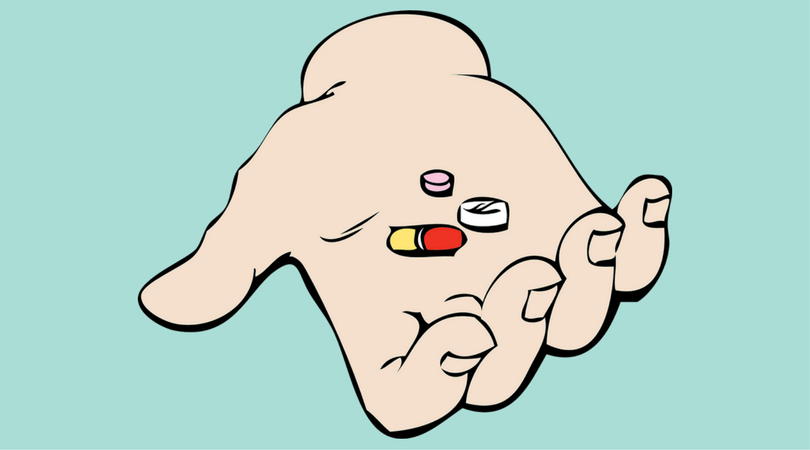Polypharmacy: Too Many Medications for Seniors?
An increase in the amount of prescribed and over-the-counter medications we take seems par for the course as we age; the more candles on our birthday cakes, the more likely we are to develop severe health problems that require consistent treatment. The effects of taking multiple medications simultaneously is known as polypharmacy, and often these can lead to an ADE, or an “adverse drug event.”
So how can the taking of various medications cause such a harmful reaction? Aren’t the medications doctors prescribe tested and considered safe?
Problems arise when a physician is not aware of all the medications their patient is taking, as they may unknowingly prescribe a drug that interacts poorly with something the patient already uses. Commonly used over-the-counter drugs, like acetaminophen and aspirin, can be dangerous when taken in combination with certain medications, and they often go unmentioned when a physician asks about a patient’s daily regimen. Additionally, it is estimated that 50% of seniors take at least one medication or supplement that is unnecessary.
But age itself is often responsible for these adverse reactions.
An older body may have more fat and less water than a younger body, which can change the way a drug is distributed; because there is a greater amount of fat, a drug may stay longer in the body than intended. Additionally, our liver and kidney functions tend to function less efficiently as we age, which can reduce clearance and make metabolizing and benefitting from a drug all the more difficult.
Add high blood pressure, diabetes, cardiovascular disease, high cholesterol, and other diseases which often require medication to manage, to a body which has a harder time processing said medication. While not all negative reactions to polypharmacy are life-threatening, there is the potential for an ADE if caution is not exercised in the prescription of medicine to the elderly.
Here are a few of the effects polypharmacy can have on the body:
- Non-adherence.
Medication non-adherence is, as the name suggests, when an individual does not take their medication as prescribed, or at all. A person may never take the drug in the first place, or they may take too much or too little of it, meaning they put their lives in danger by not adhering to the guidance of a medical professional. While there is no single, cut-and-dry cause of non-adherence, polypharmacy can contribute to this problem among the elderly. The more medications they have to keep track of, the more difficult it may be for them to take the appropriate dosage, or to add a new, necessary drug to their regimen. Straying from their treatment plan can result in the worsening of their condition or hospitalization. At worst, non-adherence can lead to a fatal ADE.
- Cognitive and Functional Decline
There is some evidence to suggest that polypharmacy (in this case, taking more than 5 medications) increases the likelihood of both delirium and dementia. Cognitive impairments could lead to medication non-adherence, which could in turn cause a senior’s condition to worsen. Polypharmacy also seems to inhibit bodily functioning as a whole, and seniors taking a great number of medicines may experience difficulties in performing essential daily tasks.
- Fragility
Research shows that there is a potential connection between polypharmacy and an increased risk of falling. For the elderly, a fall is not merely a painful stumble; it can cause significant health problems, like a broken hip, that can be extremely difficult to recover from. Frequent falling is associated with both increased morbidity and increased mortality, and should never be taken lightly when it occurs in an elderly person. Polypharmacy may escalate falling episodes in those who are already frail and at risk.
The concerns listed above are only a few of the negative effects polypharmacy can have on the elderly body. But it can also take a toll on an elderly person’s wallet. Medications are not cheap, and even with coverage, taking upwards of five different drugs can be a financial strain. If a senior does experience an adverse drug event, hospitalization and drug therapy can compound already steep medical expenses.
How can we ensure that our senior loved ones do not suffer the negative effects of taking multiple medications?
Certain medications are essential. The older we are, and the older our parents and grandparents are, the more likely we are to develop medical conditions that require drugs to manage. This is unavoidable, and there is no cause to be suspicious of the medication prescribed by doctors for these serious health problems.
That said, we need to make sure we give our regular physicians as clear a picture as possible of our medication regimen. We need to encourage our elderly loved ones to do the same, and not only where prescription drugs are concerned. Every supplement, nasal decongestant, cold remedy, and over-the-counter pain relief taken should be made known to the doctor.
Polypharmacy seems to be especially prevalent among seniors who live in nursing homes, largely because they often have multiple comorbidities and are prescribed more medication by physicians. There is some concern in the medical community that with the abundance of medicinal treatments and drugs on the market, doctors may be over-prescribing to older adults with various health conditions. As more of the population ages, better techniques for assessing a person’s medication needs may be developed, and more research will be devoted to reducing the negative effects of polypharmacy.
People are living longer than ever before, and while that is certainly something to celebrate, we are also taking prescribed medication for a longer amount of time. Many of us will take more than one prescribed medication. Seeing a doctor regularly to assess and re-asses the number and necessity of the medications we use is crucial; and this goes for our senior loved ones too. As they age and their bodies change, their medications may need to be changed or reduced; it’s vital that they see a physician at least once a year, and that if they see more than one, that they provide them all with as comprehensive a list of their medications as possible.
Contributed by Meredith Kimple


